An Analysis of the Discovery and Colonization of America Essay
VerifiedAdded on 2023/05/31
|6
|1515
|333
Essay
AI Summary
This essay delves into the discovery of America and its subsequent colonization, utilizing primary source documents such as "The Age of Exploration (1600)" and "The American Colonies [1620-1733]." It traces the Spanish expedition led by Christopher Columbus in 1492, highlighting his initial interactions with Native Americans and the subsequent European exploration and conquest. The essay also discusses the Treaty of Tordesillas, the division of the New World between Spain and Portugal, and the establishment of colonies by England, France, Spain, and the Netherlands, including the Massachusetts Bay Colony and the Mayflower Compact. Ultimately, the essay emphasizes the combined efforts of various explorers and colonizers in shaping America's historical development.
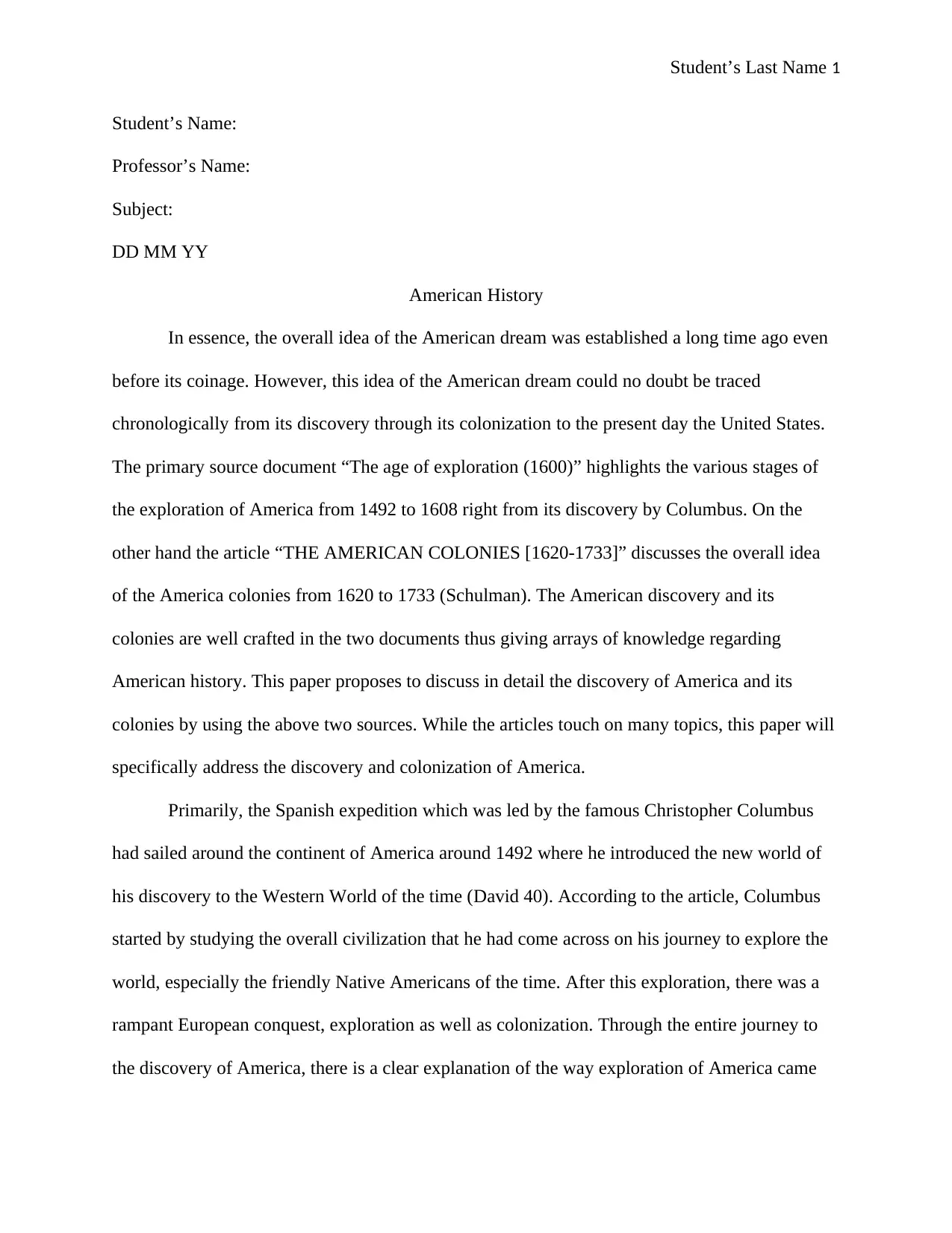
Student’s Last Name 1
Student’s Name:
Professor’s Name:
Subject:
DD MM YY
American History
In essence, the overall idea of the American dream was established a long time ago even
before its coinage. However, this idea of the American dream could no doubt be traced
chronologically from its discovery through its colonization to the present day the United States.
The primary source document “The age of exploration (1600)” highlights the various stages of
the exploration of America from 1492 to 1608 right from its discovery by Columbus. On the
other hand the article “THE AMERICAN COLONIES [1620-1733]” discusses the overall idea
of the America colonies from 1620 to 1733 (Schulman). The American discovery and its
colonies are well crafted in the two documents thus giving arrays of knowledge regarding
American history. This paper proposes to discuss in detail the discovery of America and its
colonies by using the above two sources. While the articles touch on many topics, this paper will
specifically address the discovery and colonization of America.
Primarily, the Spanish expedition which was led by the famous Christopher Columbus
had sailed around the continent of America around 1492 where he introduced the new world of
his discovery to the Western World of the time (David 40). According to the article, Columbus
started by studying the overall civilization that he had come across on his journey to explore the
world, especially the friendly Native Americans of the time. After this exploration, there was a
rampant European conquest, exploration as well as colonization. Through the entire journey to
the discovery of America, there is a clear explanation of the way exploration of America came
Student’s Name:
Professor’s Name:
Subject:
DD MM YY
American History
In essence, the overall idea of the American dream was established a long time ago even
before its coinage. However, this idea of the American dream could no doubt be traced
chronologically from its discovery through its colonization to the present day the United States.
The primary source document “The age of exploration (1600)” highlights the various stages of
the exploration of America from 1492 to 1608 right from its discovery by Columbus. On the
other hand the article “THE AMERICAN COLONIES [1620-1733]” discusses the overall idea
of the America colonies from 1620 to 1733 (Schulman). The American discovery and its
colonies are well crafted in the two documents thus giving arrays of knowledge regarding
American history. This paper proposes to discuss in detail the discovery of America and its
colonies by using the above two sources. While the articles touch on many topics, this paper will
specifically address the discovery and colonization of America.
Primarily, the Spanish expedition which was led by the famous Christopher Columbus
had sailed around the continent of America around 1492 where he introduced the new world of
his discovery to the Western World of the time (David 40). According to the article, Columbus
started by studying the overall civilization that he had come across on his journey to explore the
world, especially the friendly Native Americans of the time. After this exploration, there was a
rampant European conquest, exploration as well as colonization. Through the entire journey to
the discovery of America, there is a clear explanation of the way exploration of America came
Paraphrase This Document
Need a fresh take? Get an instant paraphrase of this document with our AI Paraphraser
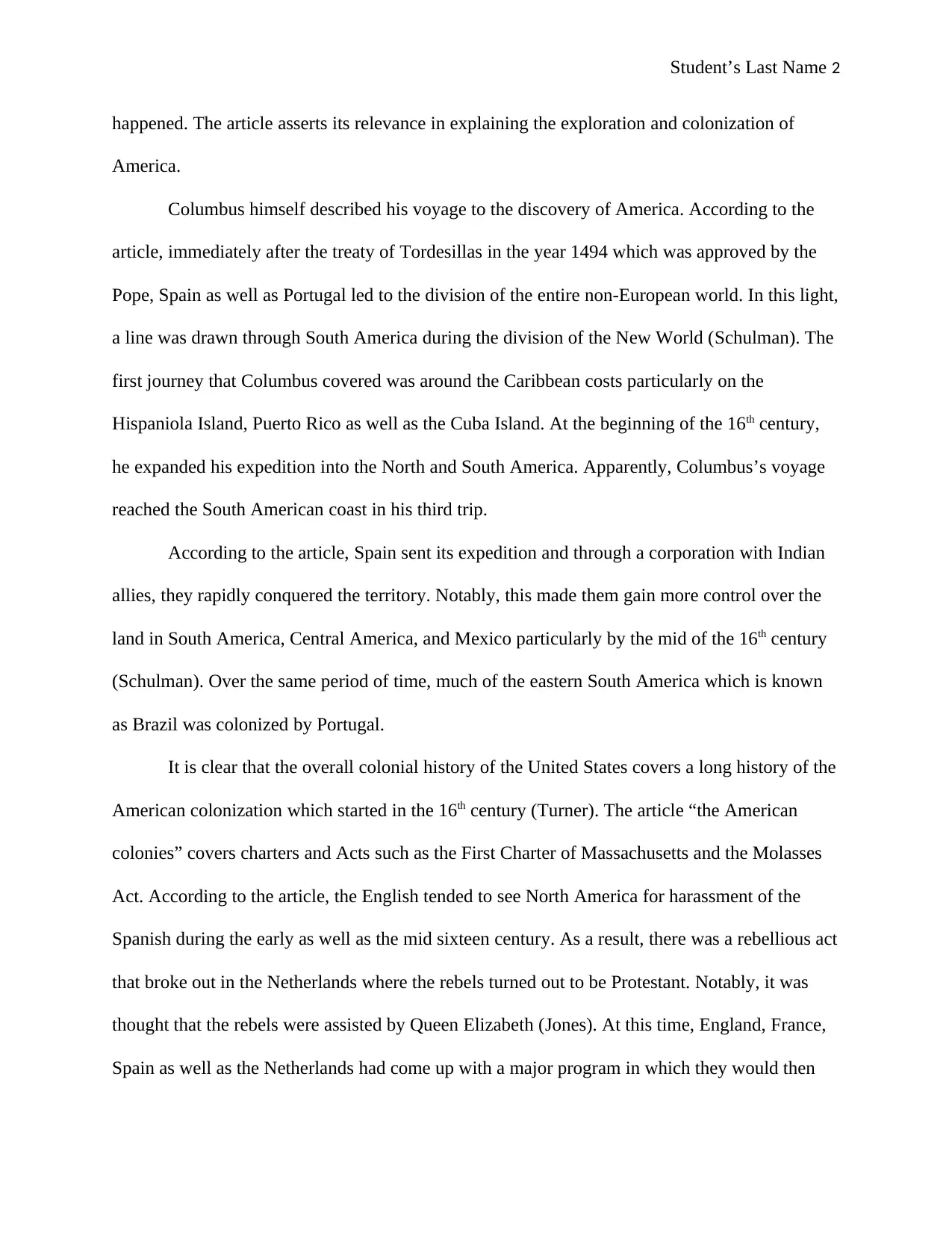
Student’s Last Name 2
happened. The article asserts its relevance in explaining the exploration and colonization of
America.
Columbus himself described his voyage to the discovery of America. According to the
article, immediately after the treaty of Tordesillas in the year 1494 which was approved by the
Pope, Spain as well as Portugal led to the division of the entire non-European world. In this light,
a line was drawn through South America during the division of the New World (Schulman). The
first journey that Columbus covered was around the Caribbean costs particularly on the
Hispaniola Island, Puerto Rico as well as the Cuba Island. At the beginning of the 16th century,
he expanded his expedition into the North and South America. Apparently, Columbus’s voyage
reached the South American coast in his third trip.
According to the article, Spain sent its expedition and through a corporation with Indian
allies, they rapidly conquered the territory. Notably, this made them gain more control over the
land in South America, Central America, and Mexico particularly by the mid of the 16th century
(Schulman). Over the same period of time, much of the eastern South America which is known
as Brazil was colonized by Portugal.
It is clear that the overall colonial history of the United States covers a long history of the
American colonization which started in the 16th century (Turner). The article “the American
colonies” covers charters and Acts such as the First Charter of Massachusetts and the Molasses
Act. According to the article, the English tended to see North America for harassment of the
Spanish during the early as well as the mid sixteen century. As a result, there was a rebellious act
that broke out in the Netherlands where the rebels turned out to be Protestant. Notably, it was
thought that the rebels were assisted by Queen Elizabeth (Jones). At this time, England, France,
Spain as well as the Netherlands had come up with a major program in which they would then
happened. The article asserts its relevance in explaining the exploration and colonization of
America.
Columbus himself described his voyage to the discovery of America. According to the
article, immediately after the treaty of Tordesillas in the year 1494 which was approved by the
Pope, Spain as well as Portugal led to the division of the entire non-European world. In this light,
a line was drawn through South America during the division of the New World (Schulman). The
first journey that Columbus covered was around the Caribbean costs particularly on the
Hispaniola Island, Puerto Rico as well as the Cuba Island. At the beginning of the 16th century,
he expanded his expedition into the North and South America. Apparently, Columbus’s voyage
reached the South American coast in his third trip.
According to the article, Spain sent its expedition and through a corporation with Indian
allies, they rapidly conquered the territory. Notably, this made them gain more control over the
land in South America, Central America, and Mexico particularly by the mid of the 16th century
(Schulman). Over the same period of time, much of the eastern South America which is known
as Brazil was colonized by Portugal.
It is clear that the overall colonial history of the United States covers a long history of the
American colonization which started in the 16th century (Turner). The article “the American
colonies” covers charters and Acts such as the First Charter of Massachusetts and the Molasses
Act. According to the article, the English tended to see North America for harassment of the
Spanish during the early as well as the mid sixteen century. As a result, there was a rebellious act
that broke out in the Netherlands where the rebels turned out to be Protestant. Notably, it was
thought that the rebels were assisted by Queen Elizabeth (Jones). At this time, England, France,
Spain as well as the Netherlands had come up with a major program in which they would then
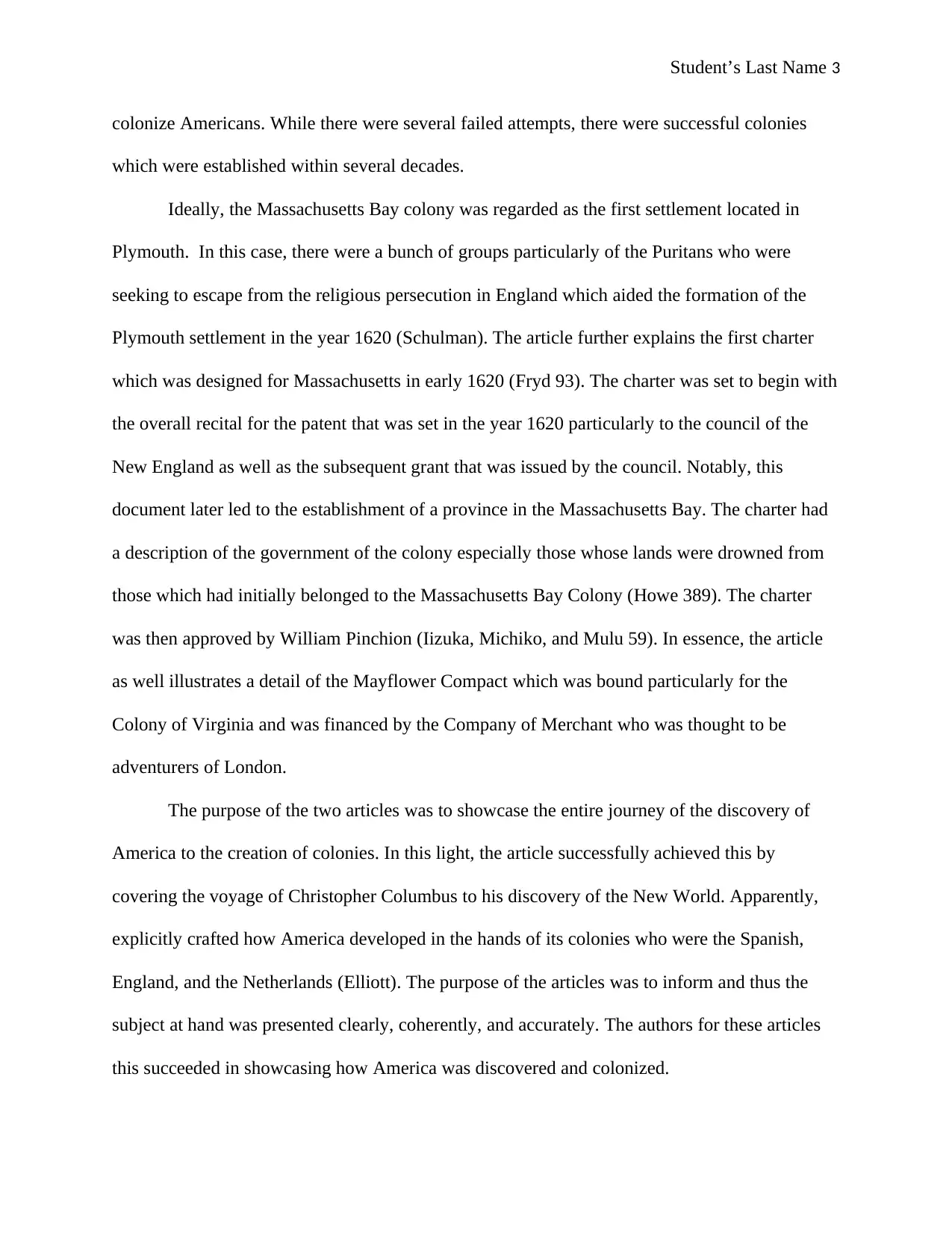
Student’s Last Name 3
colonize Americans. While there were several failed attempts, there were successful colonies
which were established within several decades.
Ideally, the Massachusetts Bay colony was regarded as the first settlement located in
Plymouth. In this case, there were a bunch of groups particularly of the Puritans who were
seeking to escape from the religious persecution in England which aided the formation of the
Plymouth settlement in the year 1620 (Schulman). The article further explains the first charter
which was designed for Massachusetts in early 1620 (Fryd 93). The charter was set to begin with
the overall recital for the patent that was set in the year 1620 particularly to the council of the
New England as well as the subsequent grant that was issued by the council. Notably, this
document later led to the establishment of a province in the Massachusetts Bay. The charter had
a description of the government of the colony especially those whose lands were drowned from
those which had initially belonged to the Massachusetts Bay Colony (Howe 389). The charter
was then approved by William Pinchion (Iizuka, Michiko, and Mulu 59). In essence, the article
as well illustrates a detail of the Mayflower Compact which was bound particularly for the
Colony of Virginia and was financed by the Company of Merchant who was thought to be
adventurers of London.
The purpose of the two articles was to showcase the entire journey of the discovery of
America to the creation of colonies. In this light, the article successfully achieved this by
covering the voyage of Christopher Columbus to his discovery of the New World. Apparently,
explicitly crafted how America developed in the hands of its colonies who were the Spanish,
England, and the Netherlands (Elliott). The purpose of the articles was to inform and thus the
subject at hand was presented clearly, coherently, and accurately. The authors for these articles
this succeeded in showcasing how America was discovered and colonized.
colonize Americans. While there were several failed attempts, there were successful colonies
which were established within several decades.
Ideally, the Massachusetts Bay colony was regarded as the first settlement located in
Plymouth. In this case, there were a bunch of groups particularly of the Puritans who were
seeking to escape from the religious persecution in England which aided the formation of the
Plymouth settlement in the year 1620 (Schulman). The article further explains the first charter
which was designed for Massachusetts in early 1620 (Fryd 93). The charter was set to begin with
the overall recital for the patent that was set in the year 1620 particularly to the council of the
New England as well as the subsequent grant that was issued by the council. Notably, this
document later led to the establishment of a province in the Massachusetts Bay. The charter had
a description of the government of the colony especially those whose lands were drowned from
those which had initially belonged to the Massachusetts Bay Colony (Howe 389). The charter
was then approved by William Pinchion (Iizuka, Michiko, and Mulu 59). In essence, the article
as well illustrates a detail of the Mayflower Compact which was bound particularly for the
Colony of Virginia and was financed by the Company of Merchant who was thought to be
adventurers of London.
The purpose of the two articles was to showcase the entire journey of the discovery of
America to the creation of colonies. In this light, the article successfully achieved this by
covering the voyage of Christopher Columbus to his discovery of the New World. Apparently,
explicitly crafted how America developed in the hands of its colonies who were the Spanish,
England, and the Netherlands (Elliott). The purpose of the articles was to inform and thus the
subject at hand was presented clearly, coherently, and accurately. The authors for these articles
this succeeded in showcasing how America was discovered and colonized.
⊘ This is a preview!⊘
Do you want full access?
Subscribe today to unlock all pages.

Trusted by 1+ million students worldwide
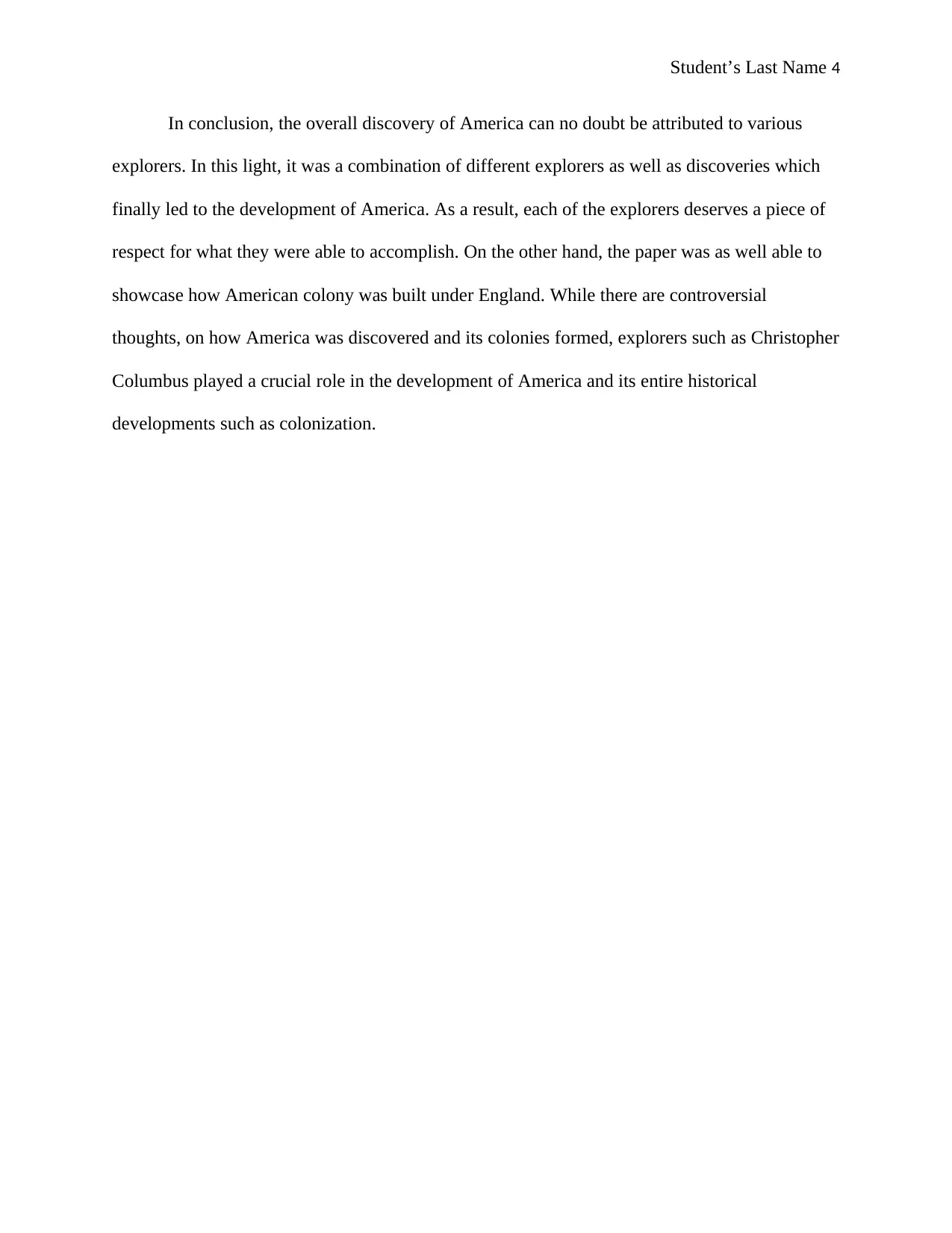
Student’s Last Name 4
In conclusion, the overall discovery of America can no doubt be attributed to various
explorers. In this light, it was a combination of different explorers as well as discoveries which
finally led to the development of America. As a result, each of the explorers deserves a piece of
respect for what they were able to accomplish. On the other hand, the paper was as well able to
showcase how American colony was built under England. While there are controversial
thoughts, on how America was discovered and its colonies formed, explorers such as Christopher
Columbus played a crucial role in the development of America and its entire historical
developments such as colonization.
In conclusion, the overall discovery of America can no doubt be attributed to various
explorers. In this light, it was a combination of different explorers as well as discoveries which
finally led to the development of America. As a result, each of the explorers deserves a piece of
respect for what they were able to accomplish. On the other hand, the paper was as well able to
showcase how American colony was built under England. While there are controversial
thoughts, on how America was discovered and its colonies formed, explorers such as Christopher
Columbus played a crucial role in the development of America and its entire historical
developments such as colonization.
Paraphrase This Document
Need a fresh take? Get an instant paraphrase of this document with our AI Paraphraser
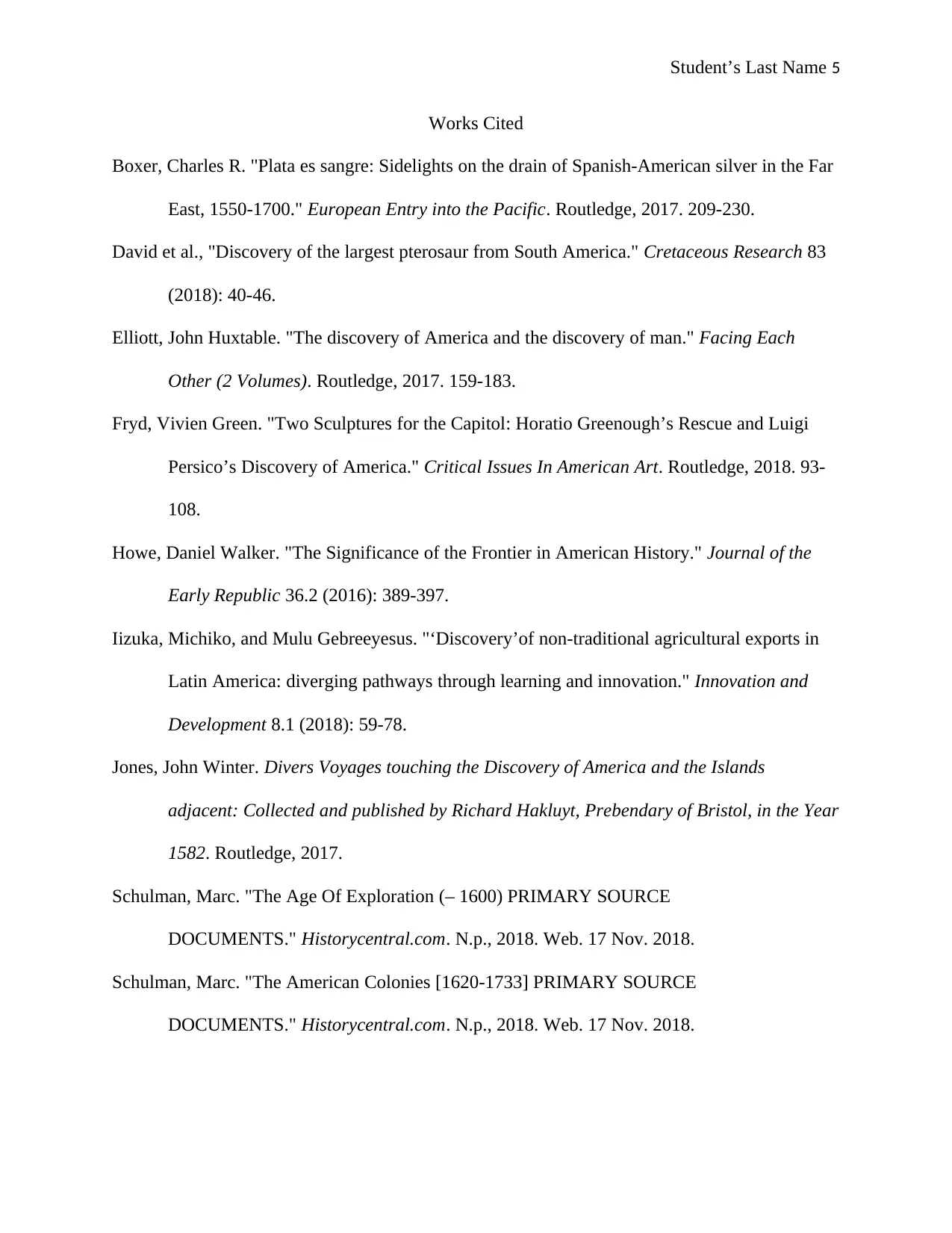
Student’s Last Name 5
Works Cited
Boxer, Charles R. "Plata es sangre: Sidelights on the drain of Spanish-American silver in the Far
East, 1550-1700." European Entry into the Pacific. Routledge, 2017. 209-230.
David et al., "Discovery of the largest pterosaur from South America." Cretaceous Research 83
(2018): 40-46.
Elliott, John Huxtable. "The discovery of America and the discovery of man." Facing Each
Other (2 Volumes). Routledge, 2017. 159-183.
Fryd, Vivien Green. "Two Sculptures for the Capitol: Horatio Greenough’s Rescue and Luigi
Persico’s Discovery of America." Critical Issues In American Art. Routledge, 2018. 93-
108.
Howe, Daniel Walker. "The Significance of the Frontier in American History." Journal of the
Early Republic 36.2 (2016): 389-397.
Iizuka, Michiko, and Mulu Gebreeyesus. "‘Discovery’of non-traditional agricultural exports in
Latin America: diverging pathways through learning and innovation." Innovation and
Development 8.1 (2018): 59-78.
Jones, John Winter. Divers Voyages touching the Discovery of America and the Islands
adjacent: Collected and published by Richard Hakluyt, Prebendary of Bristol, in the Year
1582. Routledge, 2017.
Schulman, Marc. "The Age Of Exploration (– 1600) PRIMARY SOURCE
DOCUMENTS." Historycentral.com. N.p., 2018. Web. 17 Nov. 2018.
Schulman, Marc. "The American Colonies [1620-1733] PRIMARY SOURCE
DOCUMENTS." Historycentral.com. N.p., 2018. Web. 17 Nov. 2018.
Works Cited
Boxer, Charles R. "Plata es sangre: Sidelights on the drain of Spanish-American silver in the Far
East, 1550-1700." European Entry into the Pacific. Routledge, 2017. 209-230.
David et al., "Discovery of the largest pterosaur from South America." Cretaceous Research 83
(2018): 40-46.
Elliott, John Huxtable. "The discovery of America and the discovery of man." Facing Each
Other (2 Volumes). Routledge, 2017. 159-183.
Fryd, Vivien Green. "Two Sculptures for the Capitol: Horatio Greenough’s Rescue and Luigi
Persico’s Discovery of America." Critical Issues In American Art. Routledge, 2018. 93-
108.
Howe, Daniel Walker. "The Significance of the Frontier in American History." Journal of the
Early Republic 36.2 (2016): 389-397.
Iizuka, Michiko, and Mulu Gebreeyesus. "‘Discovery’of non-traditional agricultural exports in
Latin America: diverging pathways through learning and innovation." Innovation and
Development 8.1 (2018): 59-78.
Jones, John Winter. Divers Voyages touching the Discovery of America and the Islands
adjacent: Collected and published by Richard Hakluyt, Prebendary of Bristol, in the Year
1582. Routledge, 2017.
Schulman, Marc. "The Age Of Exploration (– 1600) PRIMARY SOURCE
DOCUMENTS." Historycentral.com. N.p., 2018. Web. 17 Nov. 2018.
Schulman, Marc. "The American Colonies [1620-1733] PRIMARY SOURCE
DOCUMENTS." Historycentral.com. N.p., 2018. Web. 17 Nov. 2018.
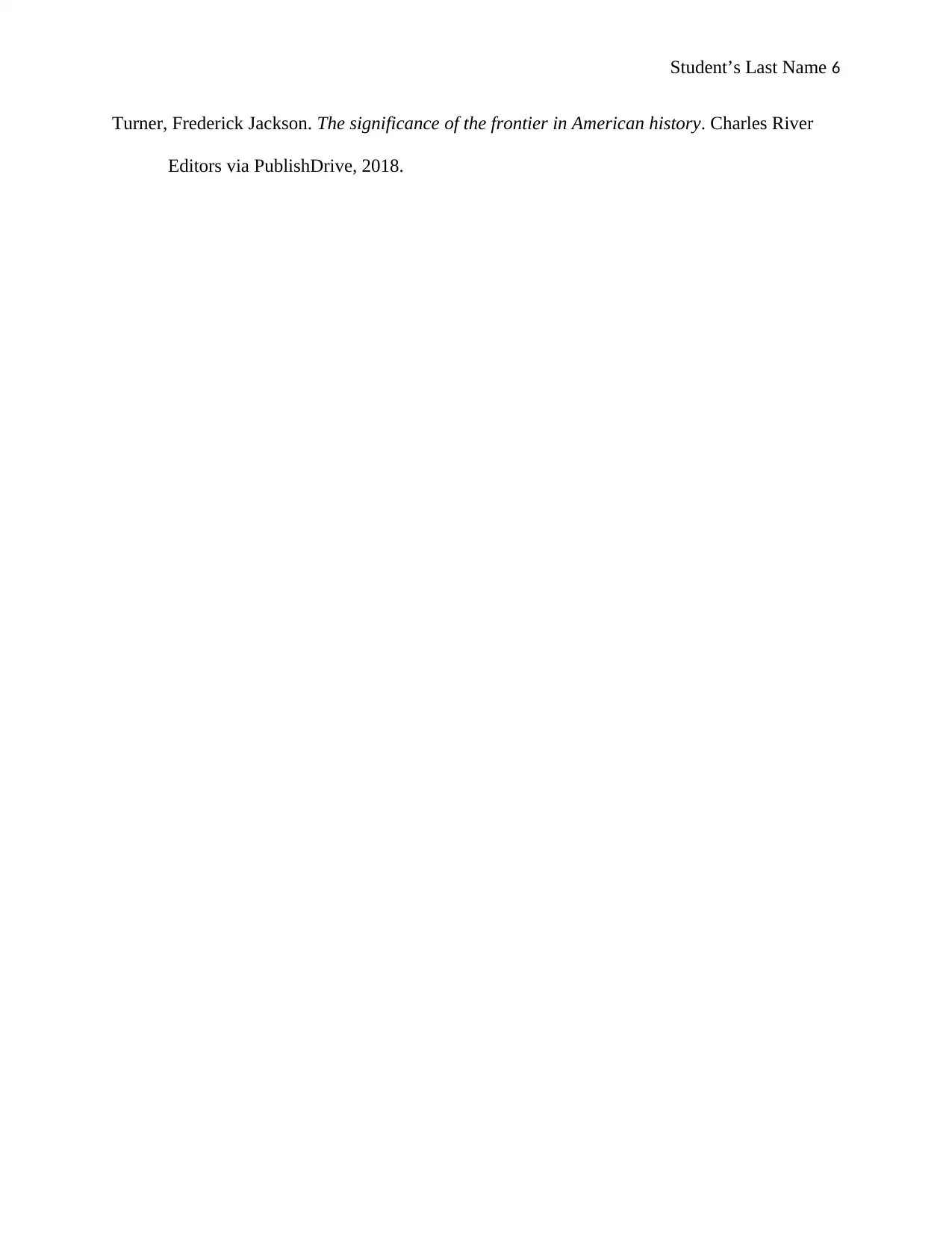
Student’s Last Name 6
Turner, Frederick Jackson. The significance of the frontier in American history. Charles River
Editors via PublishDrive, 2018.
Turner, Frederick Jackson. The significance of the frontier in American history. Charles River
Editors via PublishDrive, 2018.
⊘ This is a preview!⊘
Do you want full access?
Subscribe today to unlock all pages.

Trusted by 1+ million students worldwide
1 out of 6
Your All-in-One AI-Powered Toolkit for Academic Success.
+13062052269
info@desklib.com
Available 24*7 on WhatsApp / Email
![[object Object]](/_next/static/media/star-bottom.7253800d.svg)
Unlock your academic potential
Copyright © 2020–2025 A2Z Services. All Rights Reserved. Developed and managed by ZUCOL.
